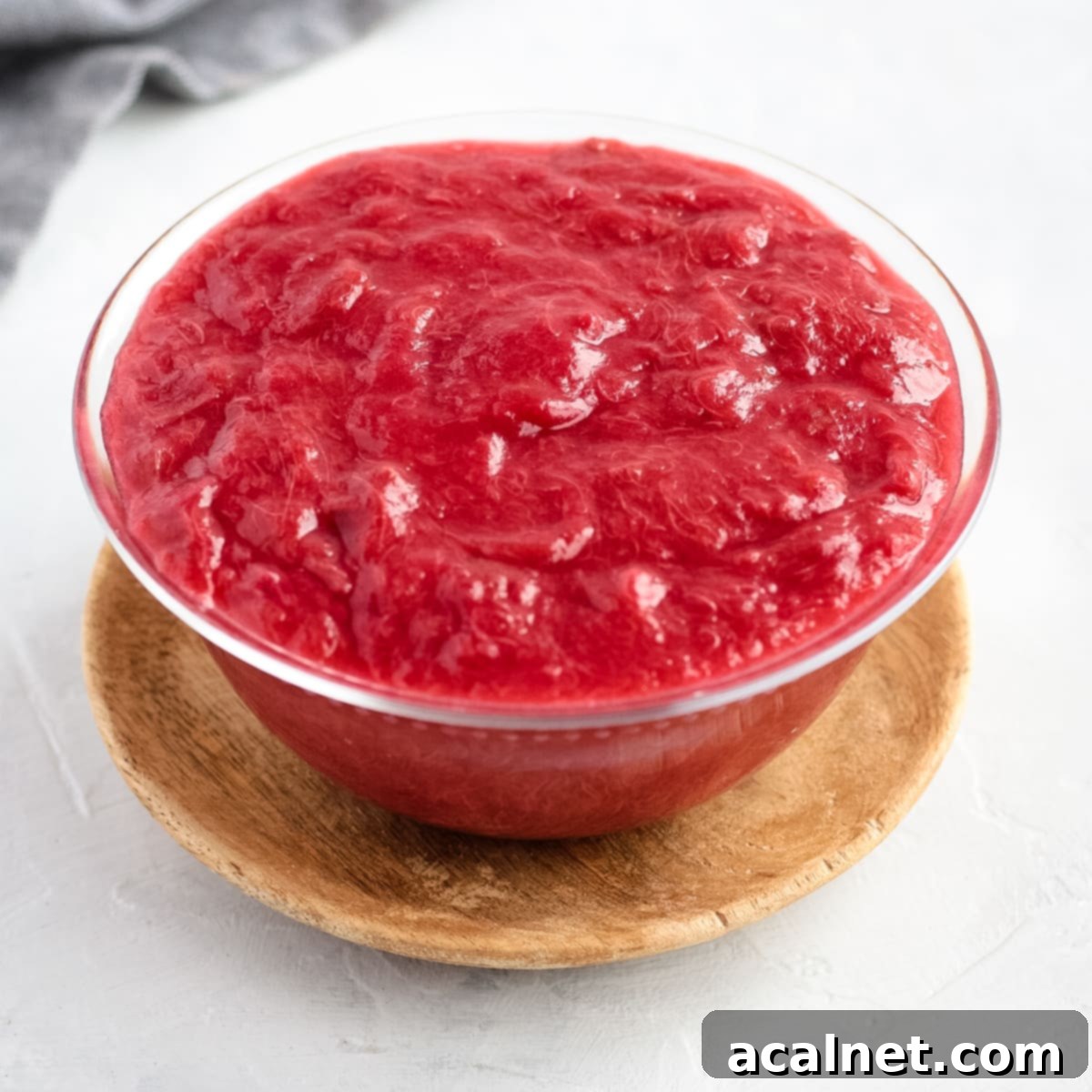Easy 3-Ingredient Stewed Rhubarb: Your Go-To Recipe for Delicious Rhubarb Compote & Sauce
Welcome to the wonderful world of stewed rhubarb! This incredibly simple recipe, requiring just three basic ingredients, transforms fresh rhubarb into a versatile, luscious fruity sauce. Perfect for topping your favorite desserts, cakes, yogurt, or any sweet breakfast dish, this homemade rhubarb compote is a delightful way to enjoy the season’s bounty. In less than 30 minutes, you’ll have a vibrant, tangy-sweet creation ready to elevate your culinary adventures.
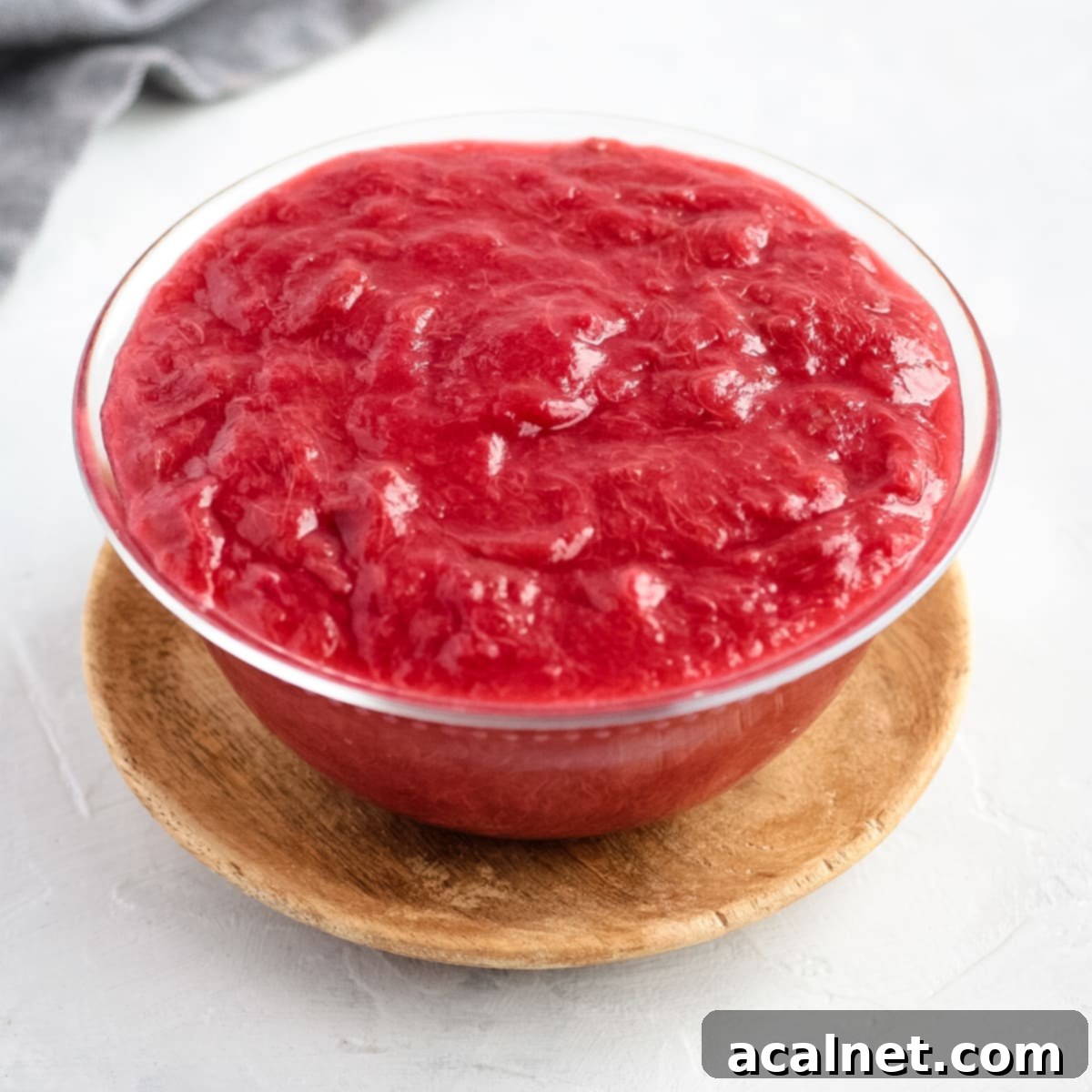
[feast_advanced_jump_to]
Why You’ll Adore This Easy Stewed Rhubarb Recipe
If you’ve got fresh rhubarb on hand and are searching for a quick, effortless recipe that truly lets its unique flavor shine, then this rhubarb compote is an absolute must-try! Stewing is, without a doubt, one of the best ways to cook rhubarb. It’s incredibly fast, requires minimal effort, and yields an utterly delicious, vibrant rhubarb sauce that is astonishingly versatile. Its beautiful pink hue and distinctive tartness make it a standout ingredient in countless dishes.
Made with just three essential ingredients – rhubarb, water, and sugar – this truly is the easiest and most delicious stewed rhubarb recipe you’ll ever find. Much like stewed pears are a winter comfort, this rhubarb compote brightens up spring and summer. Its simplicity means it can easily be customized with your favorite spices, complementary fruits, or zesty condiments to create an endless array of flavor profiles.
I recently used this stewed rhubarb to craft a sensational Rhubarb Custard Tart, and the results were absolutely divine. But its uses extend far beyond tarts! Imagine it drizzled warm over a scoop of vanilla bean ice cream, nestled alongside fresh berries for a light dessert, or as a vibrant topping for your morning yogurt or pancakes. The possibilities are truly limitless, making this recipe a staple for any home cook.
Essential 3-Ingredient Rhubarb Stew Ingredients
The beauty of this recipe lies in its simplicity. You only need three core ingredients to create this fantastic rhubarb sauce (full quantities can be found in the recipe card below):
- Fresh Rhubarb
- Water
- Granulated Sugar
Couldn’t be simpler, right? The quality of these basic ingredients will shine through, so opt for fresh, firm rhubarb stalks if possible. You can use any type of rhubarb available to you. While I typically find beautiful red rhubarb in my local markets, which gives the compote a lovely pink tint, green rhubarb varieties will work just as well, delivering the same delicious flavor profile.
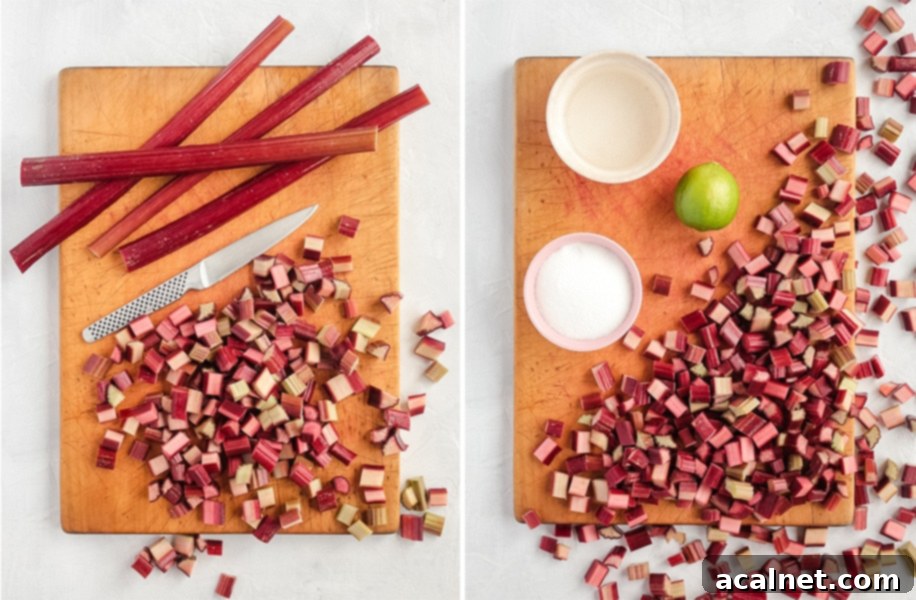
Elevate Your Rhubarb: Optional Flavor Additions
While delicious on its own, stewed rhubarb is also a fantastic base for experimenting with additional flavors. Here are some of my favorite ways to enhance this simple compote:
- **Citrus Zing:** I personally adore adding Lime juice and zest to my stewed rhubarb. The bright, tangy notes of lime beautifully complement rhubarb’s natural tartness, adding an extra layer of freshness. If lime isn’t your preference, fresh lemon juice and zest offer a similar vibrant tang, while orange juice and zest will lend a sweeter, more aromatic touch.
- **Fruity Pairings:** Rhubarb plays wonderfully with other fruits. Consider adding sliced strawberries to create the classic strawberry-rhubarb combination, or diced apples for a slightly different texture and sweetness. Berries, cherries, or even peaches can also be incorporated for unique flavor twists. Just ensure to adjust cooking times slightly if adding firmer fruits.
- **Warm Spices:** Spices can truly transform your rhubarb compote. Ground ginger is a perennial favorite, adding a delightful warmth and gentle kick that pairs exquisitely with rhubarb. Other spices that work wonderfully include cardamom (for an exotic, floral note), nutmeg (for comforting warmth), or a touch of allspice. For the rhubarb compote I used in my Rhubarb Custard Tart, I opted for a blend of cinnamon and star anise, which infused the fruit with an incredible, inviting aroma and rich, warm flavor.
- **Sweetener Variations:** While white sugar is standard, you can experiment with other sweeteners like brown sugar (for a deeper, caramel-like flavor), honey, maple syrup, or agave nectar for alternative sweetness.
The combinations and possibilities are truly infinite, allowing you to tailor this easy stewed rhubarb recipe to your personal taste and the dish you plan to use it in!
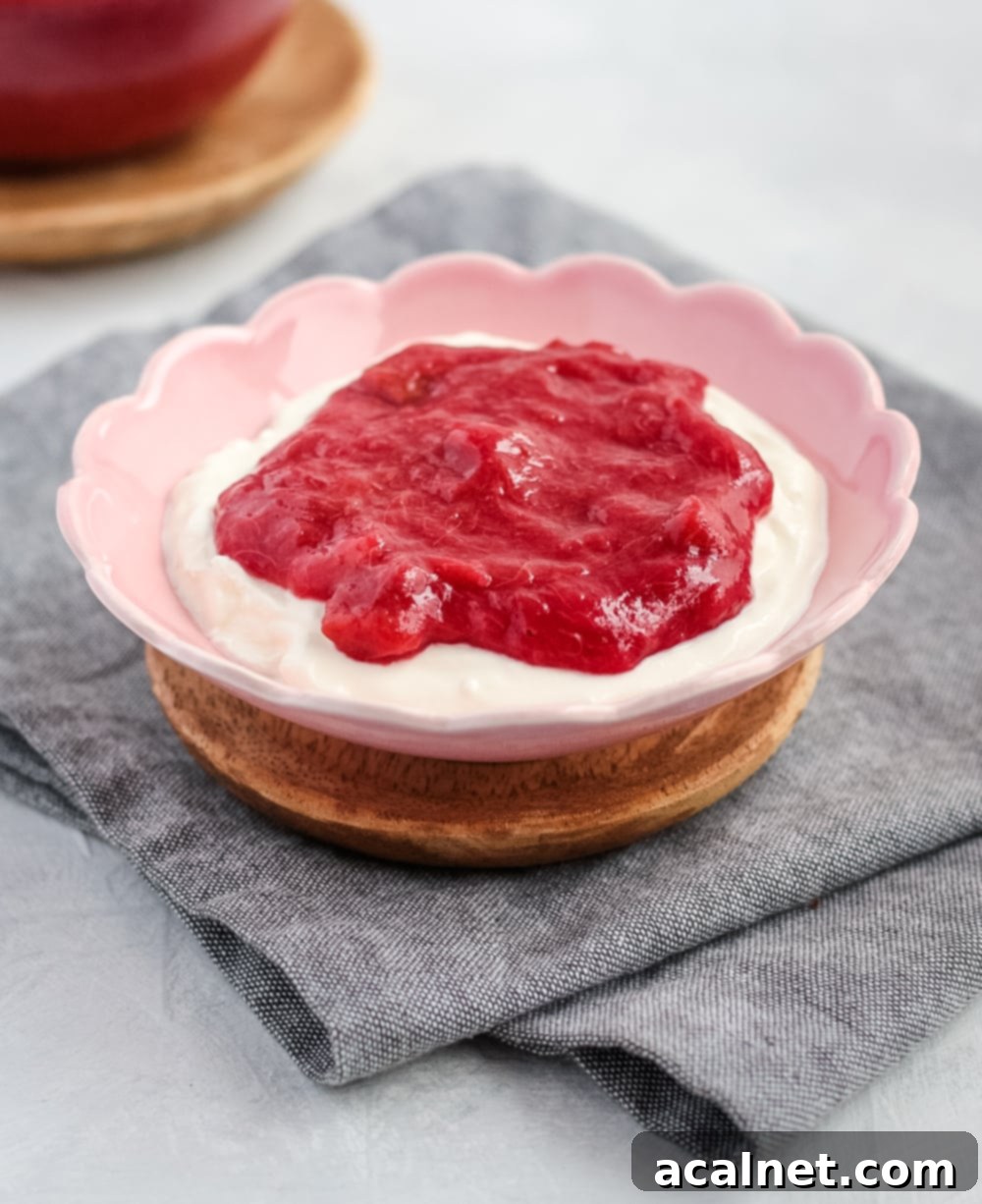
Step-by-Step Guide: How to Stew Rhubarb Perfectly
Mastering the art of stewing rhubarb is incredibly straightforward, relying on gentle heat to break down the fibrous stalks into a tender, flavorful sauce. Here’s a detailed guide to achieve the best results:
- First, begin by thoroughly washing the Rhubarb stalks under cold running water. Next, prepare the stalks by removing the tough bottom ends and, most importantly, the leaves. Remember, rhubarb leaves are poisonous and should never be consumed!
- Once cleaned, slice the Rhubarb Stalks into small, uniform pieces, roughly 1/2 to 1 inch (1.2 to 2.5 cm) in length. The smaller and more consistent your slices, the faster and more evenly the rhubarb will cook down into a soft compote.
- Place all the sliced rhubarb into a small to medium-sized pot or saucepan. Add the measured Water and Caster Sugar. Give everything a quick stir to ensure the sugar is evenly distributed amongst the rhubarb pieces.
- Optional: If you’re using citrus, now is the time to add the fresh juice and zest of a Lime (or lemon/orange) into the pot, stirring gently to combine. This adds a beautiful brightness to the compote.
- Turn on your stove to a low to medium heat. Bring the mixture to a gentle simmer, then cover the pot and allow it to cook for approximately 10 to 15 minutes. Make sure to stir regularly, every few minutes, to prevent sticking and ensure even cooking. The exact cooking time can vary slightly depending on the ripeness and thickness of your rhubarb stalks; some might require a few extra minutes.
Once the rhubarb is cooked, I highly recommend tasting the stew. Rhubarb’s tartness can vary significantly, so you might find it needs a little extra sweetness. If it tastes too sour for your liking, simply stir in an additional tablespoon of sugar at a time, allowing it to dissolve completely into the warm sauce until you reach your desired sweetness level.
The rhubarb stew is typically ready when the fruit pieces have softened, broken apart, and begun to form a thick sauce, often with charming small chunks of fruit still visible. If you prefer a more reduced, jam-like consistency or want absolutely no chunks, you can continue to cook it for a few more minutes, stirring frequently, until it reaches your preferred thickness.
For those who desire a completely smooth sauce, once cooked, you can easily blend the stew using an immersion blender directly in the pot. For an extra silken texture, pass the blended sauce through a fine-mesh sieve to remove any remaining fibrous bits, leaving you with a perfectly smooth, liquid compote.
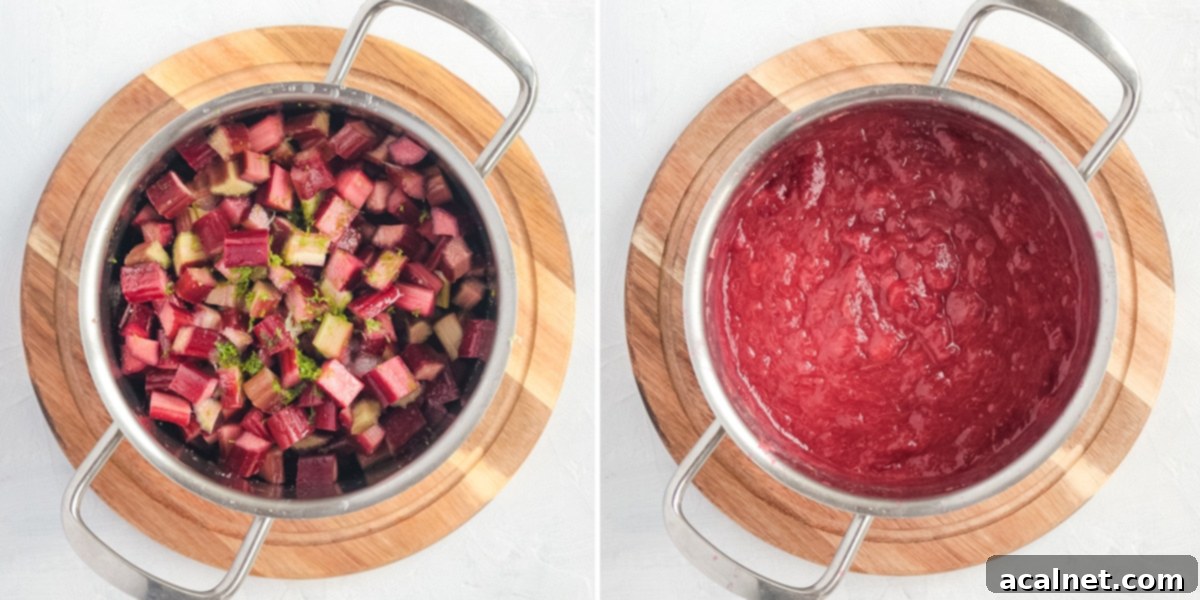
Frequently Asked Questions About Stewed Rhubarb
Absolutely, using frozen rhubarb is a convenient option, especially outside of rhubarb season! You can place the frozen rhubarb directly into the pot with the water and sugar – no need to thaw it first. Just be aware that frozen rhubarb tends to release more liquid as it thaws and cooks, so you might need to increase the cooking time slightly to allow this extra moisture to evaporate and achieve your desired consistency.
Whether or not to peel rhubarb largely depends on the specific stalks you’re using. Younger, tender rhubarb stalks usually do not need to be peeled, as their skin is delicate and will soften nicely during cooking. However, if your rhubarb stalks are older, very thick, or appear noticeably stringy and tough, then yes, peeling them is highly recommended. Peeling will result in a much smoother, more pleasant texture for your stewed rhubarb, preventing any unwanted stringiness in the final product. Simply use a vegetable peeler to remove the outer layer, much like you would with celery.
If you’re looking for a healthier or sugar-free stewed rhubarb recipe, it can certainly be made without traditional white sugar. You can substitute with natural liquid sweeteners like honey, maple syrup, or agave syrup. Other options include unrefined coconut sugar or even artificial sweeteners like stevia or erythritol. Keep in mind that using liquid sweeteners will add more moisture to the stew, so you may need to cook it for a longer period to allow the extra liquid to evaporate and achieve a thicker, more concentrated sauce. Adjust the amount of sweetener to your taste, as rhubarb’s tartness can vary.
No, this specific recipe for stewed rhubarb is not designed or safe for traditional canning or long-term preservation at room temperature. The amount of sugar in this compote is generally not high enough to act as a safe preservative for shelf-stable canning. For safety, this stewed rhubarb should always be kept in the refrigerator. If you’re looking for long-term storage, freezing is your best and safest option (see the section below on freezing).
Storing Your Homemade Rhubarb Compote
Once your delicious stewed rhubarb has finished cooking, it’s important to allow it to cool down completely to room temperature before storing. This prevents condensation from forming and helps maintain its quality. After it has cooled, transfer the compote into a clean, airtight jar or a sealed food storage container. An old, sterilized jam jar works perfectly for this purpose, giving it a charming homemade feel.
Properly stored in the refrigerator, this versatile rhubarb compote will stay fresh and delicious for an impressive 1 to 2 weeks, making it an excellent candidate for meal prep or enjoying over several days.
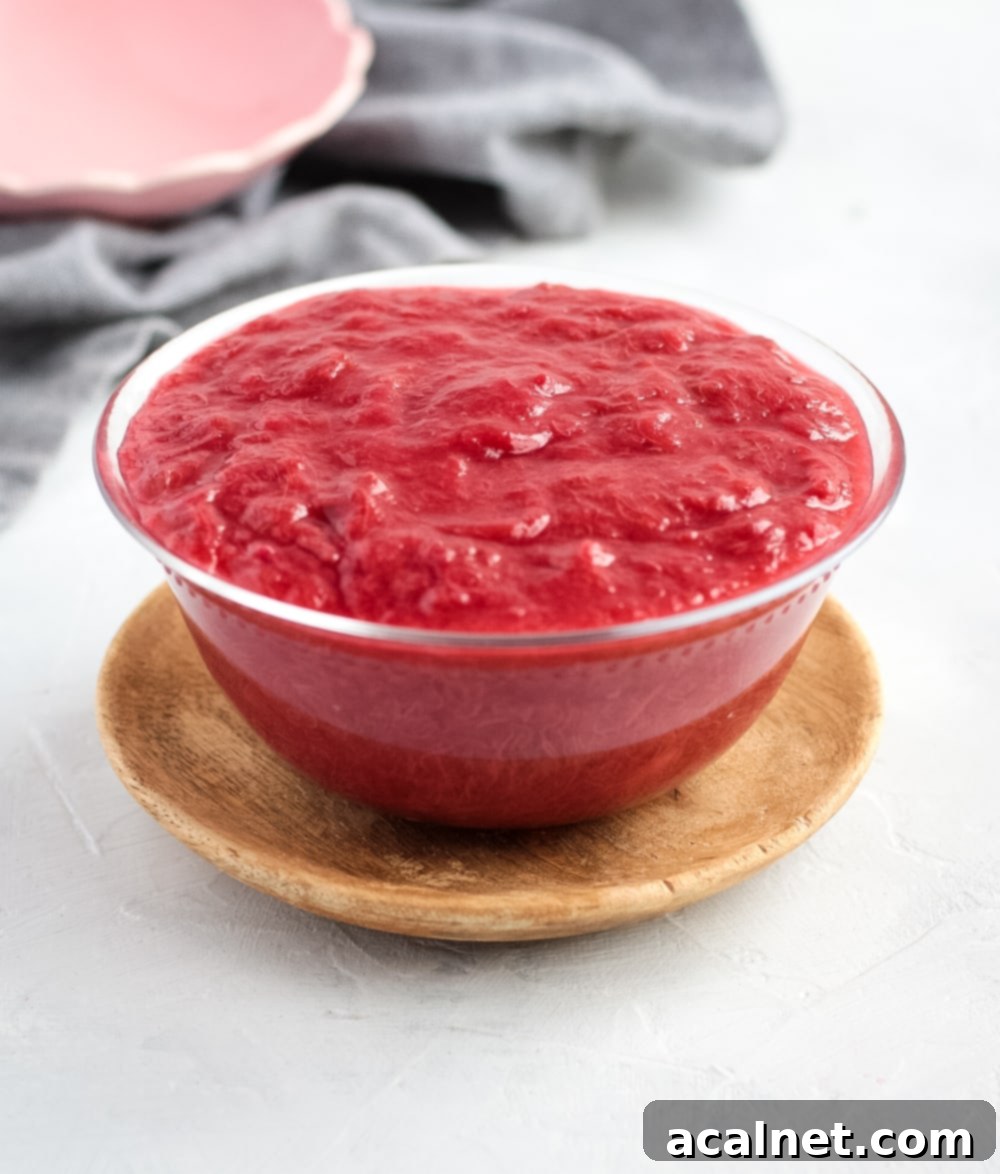
Can I Freeze This Delicious Rhubarb Sauce?
Absolutely! Whether you’ve made a large batch during peak rhubarb season or simply want to prepare it in advance, freezing stewed rhubarb is an excellent way to preserve its fresh flavor and enjoy it much later. It’s incredibly simple to do.
Once your rhubarb compote has completely cooled down to room temperature, transfer it into freezer-friendly containers or sturdy freezer bags. For convenience and easy portioning, you can even freeze it in smaller quantities using an ice cube tray. Once frozen solid, transfer the cubes to a freezer bag for long-term storage.
Properly sealed and frozen, this delightful rhubarb sauce will maintain its quality and freshness in the freezer for up to 3 months. While it can safely be kept frozen for much longer, for optimal taste and texture, consuming it within three months is recommended. When you’re ready to use it, simply thaw it in the refrigerator overnight or gently reheat it on the stovetop from frozen, adding a splash of water if needed to adjust consistency.
Creative Ways to Enjoy Your Homemade Rhubarb Compote
The versatility of this simple stewed rhubarb sauce is one of its greatest assets. There are truly countless delicious ways to incorporate its vibrant, tangy-sweet flavor into your meals. While my absolute favorite (and simplest) way to enjoy it is spooned generously over plain Greek yogurt, the culinary possibilities extend far beyond!
Here are some fantastic ideas for what to do with your homemade stewed rhubarb:
- Dessert & Dairy Topping: Drizzle it generously over creamy Yogurt (Greek, plain, or vanilla), warm or cold Custard, delicate Puddings, or a scoop of velvety Ice Cream. The warm, tangy compote creates a delightful contrast with cold, rich dairy.
- Baked Goods Filling & Topping: Use it as a luscious filling for classic Tarts (like a rhubarb frangipane tart) or as a vibrant Cake Filling. It also makes an exceptional Cake Topping, especially for plain pound cakes, cheesecakes, or simple sponge cakes.
- Breakfast Bliss: Elevate your morning routine by serving it as a topping for fluffy Pancakes, crispy Waffles, golden French Toast, or even simple oatmeal. It’s an instant upgrade to any sweet breakfast dish!
- Healthy & Hearty Bowls: Stir it into your morning Granola or Muesli for added fruitiness and a pleasant chew, or mix it into overnight oats for a delicious grab-and-go meal.
- Cheesecake Companion: Spoon this bright, tangy compote over a rich, creamy Cheesecake. The acidity of the rhubarb beautifully cuts through the richness, creating a perfectly balanced dessert.
- Fresh Fruit Medley: Combine it with other fresh fruits like sweet berries (strawberries, raspberries, blueberries) for a simple, healthy, and incredibly flavorful fruit salad or light dessert.
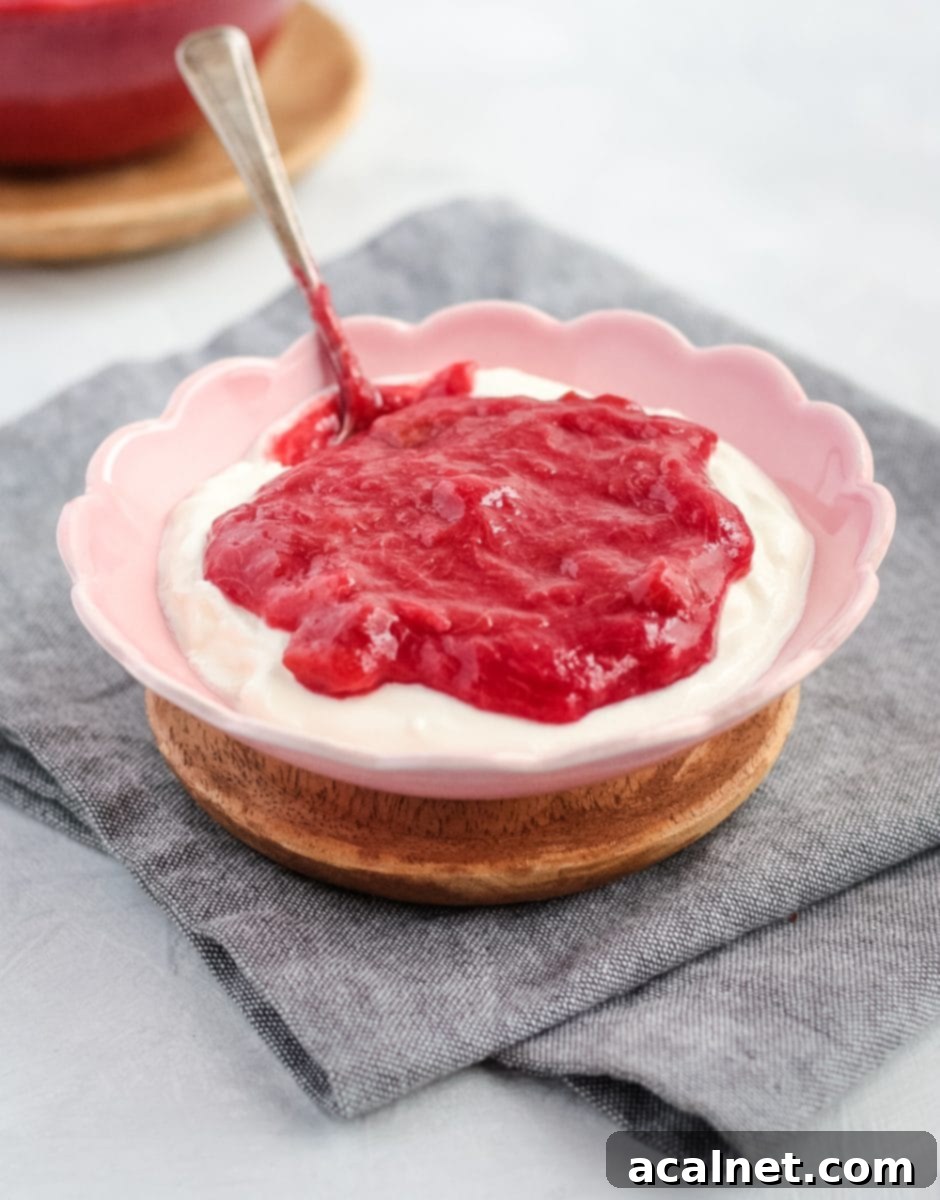
Explore More Delicious Toppings & Sauces
If you love creating homemade fruit sauces and compotes, be sure to check out these other fantastic recipes to elevate your desserts and breakfasts:
- Easy Raspberry Coulis
- Rich Whipped Ganache Frosting
- Simple Mixed Berry Compote
- Fresh Strawberry Coulis
- Tropical Mango Coulis
- Delightful Blueberry Compote
- Tangy Low Sugar Lemon Curd
- Vibrant Blueberry Coulis
Made this
recipe?
Let us know if you liked it by leaving a comment below, and tag
us on Instagram @a.baking.journey with a photo of your creation!
Recipe Card: Easy Stewed Rhubarb
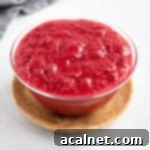
Stewed Rhubarb
votes
with 3 ingredients only, this Stewed Rhubarb Recipe makes a delicious fruity sauce that can be used to
top your favourite desserts, cakes, yogurt or sweet breakfast dishes!
1 large
jar
Sylvie
Time10 minutes
Time15 minutes
Time25 minutes
Print Recipe
Ingredients
- 500 gr (1 lb) Fresh Rhubarb
- 120 ml (1/2 cup) Water
- 80 gr (1/3 cup) White Sugar, (*)
- 1 Lime – Juice & Zest, optional
Instructions
- Wash the
Rhubarb and discard the bottom of the stalks and leaves. - Slice the
Rhubarb into small pieces and place them in a medium size Pot. Add the Water,
Sugar and Lime Juice & Zest (optional). Stir to combine. - Place on the
stove on low to medium heat and leave to simmer for about 15 minutes, or until
the rhubarb pieces are breaking apart (1), occasionally stiring. The stew is
ready once most of the rhubarb chunks have turned into a thick sauce
(2). - Remove from the
heat and leave to cool down completely, then transfer into a sealed jar. Keep in
the fridge for up to 2 weeks.
Would you like to save this recipe?
We’ll email this post to you, so you can come back to it later!
Notes
- Depending on the type of rhubarb you use and how ripe it is, the cooking time might vary. The
rhubarb will naturally break apart and turn into a thick sauce when ready. The time of cooking
also depends on the consistency you are looking for;
– stop the cooking as soon as the stew
comes together if you want a more liquid sauce
– keep cooking the fruits and leave it to
reduce for a few more minutes if you want a thicker sauce - After 15 minutes, most of my rhubarbs had turned into a sauce but I still had a few small
pieces of fruits, which I like. If you want a smoother sauce, you can cook it for longer until
all the fruits have broken apart.
(*) Note that some rhubarb can be naturally sweet while others are more
tart. I recommend tasting the stew once it is cooked and adjust the sweetness level if it tastes to
sour to your. Simply add a little bit more sugar (start with 1 tbsp) and stir it in the warm sauce
until dissolved.
Nutrition (per serving)
